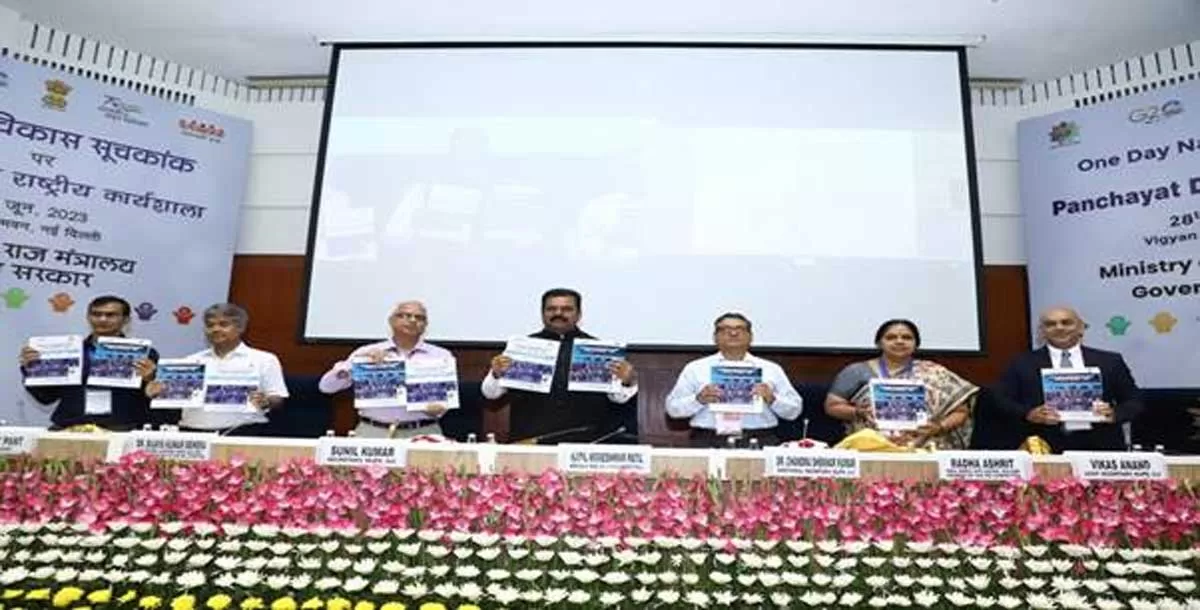- Home
- Infrastructure Urban
- SMART CITIES
- Long term focus areas to overcome COVID-19 impact
Long term focus areas to overcome COVID-19 impact
COVID-19 crisis is a bolt from the blue. There is no precedent of this particular strain of the Coronavirus , and hence, any projections of its impact can at best be treated as intelligent guesses. This is Part-5 of a series of an article written by Kunal Kumar, Joint Secretary & Mission Director (Smart Cities Mission), Ministry of Housing and Urban Affairs, Government of India, on the likely impacts of the Coronavirus on India; the best strategies going forward; and the key focus areas and actions for the short, medium and long terms.
Read more on his article on ‘Coronavirus: What have you done to our economy and society?’ here
Read more on his article on ‘Best strategies to overcome the COVID-19 impact’ here
Read more on his article on ‘Key focus areas and actions – Short term’ here
Read more on his article on ‘Key focus areas and actions – Medium term’ here
Key focus areas and actions for the long term
1. One of the telling criticisms of globalisation has been that incomes of owners of capital have risen much faster than providers of labour. In fact, median real incomes have either flattened or sloped down in many parts of the world, thus giving rise to increasing levels of income inequality on the globe. Capital begets more capital. Initial endowments play a critical role in defining future incomes. A society with unequal levels of ownership of capital and unequal access to basic services like health and education would see exacerbation of such differences as it attempts to push frontiers of economic growth. The pain having befallen on migrant workers, casual labour during the current crisis is a symptom of this larger problem of a capitalist society. Today, the state essentially looks at supporting their livelihoods through entitlement driven programmes (social pensions, public distribution system, subsidies, housing, etc); employment related programmes (NREGA, BOCW Act for construction workers, Contract Labour Act, etc); free services (free healthcare OPDs, Aayushman Bharat, free education in government schools, etc). It is important to stress that the country’s expenditure on the health and education sectors needs to go up. Merely increased expenditure will not suffice. Public institutions need to be held accountable to quality benchmarks. It is then that such institutions whether schools, colleges, hospitals would start to set service level benchmarks even for the private sector. No matter what else public sector institutions achieve, if they are able to achieve this much, they would have played their part in improving social sector services in the country by miles.
While these are laudable efforts, they still will not bestow foundational equality. A case in point is that while some academic institutes could embrace online education during the lockdown most could not, highlighting society’s digital divide. Such welfare schemes cannot act as the scaffolding to catapult the poor from poverty to prosperity because they do not make them owners of capital. The reasons are many poor quality of services, no direct incidence on growth of income, etc. Government has to prioritise redistributive justice to the poorest through effective implementation of land reforms. In a country where more than 70 per cent farmers have less than 2 hectare of land and almost 40 per cent of the workforce in agriculture is landless, no amount of support services can provide the foundation for sustainable upliftment from a state of perennial crisis. When I talk of land reforms I do not mean it in the cosmetic sense that it has been carried out so far, but in actual redistribution of land between the haves and the have-nots. The political economy has to bite this bullet before it is too late.
2. Revving up the economic engine in the long run would need more than liquidity, doles and incentives. I propose the new paradigm can be represented by the acronym FITFreedom, Incentives, Transparency. India’s industry needs more freedom to experiment, to fail, to try new horizons. We live in times of rapidly shifting landscapes in the world of products, business models, technologies, scale and speed. An army with powerful capabilities in maritime situations, when faced with an onslaught from the enemy may see its strength on paper collapsing rather rapidly. Dealing with crises is a different ballgame than business-as-usual operations. Crises like COVID-19 provide us an opportunity to reflect on how well prepared we are to deal with unimagined onslaughts on various kinds. The Indian industry has to evolve to be like an army which builds resilience through trying, failing, reflecting and building its strategy and armoury through a process of continuous learning. Such industries or firms which demonstrate resilience and keep performing better over time should find support through positive incentives while others who fail to perform should be allowed to perish without pride or prejudice. For example, while SMEs or MUDRA loan receiving entities should continue to be encouraged by providing seed capital to allow for experimentation learning to begin with, support should be continued only if they show performance on pre-decided metrics. All this should happen in a fully transparent system, where all data about the working of the ecosystem, who gets what, etc, is made available in the public domain.
3. Government’s aspirations towards becoming a 5 trillion-dollar economy are laudable. However, actions belie the aspirations. There are many priorities, programmes, and policies currently. In the absence of harmonisation among them, different actors in the economic system end up working towards different goalposts in a fragmented and inefficient manner, sub-optimally addressing the national imperative leading to its under achievement and wastage of resources in the process. While the need for different policies in different sectors cannot be denied, their tendency to work at cross purposes to each other needs acknowledgement and minimisation. The classic case is of labour laws. Even taxation laws that may seem prudent from the viewpoint of revenue collection may sometimes be detrimental to long-term economic growth. Similar is the case with urban and rural development policies, which instead of working in a symbiotic fashion, work at cross purposes to each other. Direct efforts to increase entrepreneurship have been less useful than long term investments in the acquisition of productive knowledge and building appropriate infrastructure. Even today, nearly half of India’s labour force is in agriculture, contributing merely one-sixth of its GDP. Macroeconomic policies like monetary policy, fiscal policy, industrial policy, regulatory and judicial environment, etc, have an important role to play in supporting this upward mobility in the economy but they cannot be looked at in isolation. The need of the hour is to harmonise these policies and create an escalator that supports the movement of people away from agriculture into manufacturing and services.
4. There is a need to focus urban investments through the lens of economic complexity. Cities contribute close to two-thirds of the country’s GDP.
Government programmes in the urban sector largely consist of sector (water, solid waste, etc) programmes, focused on the creation of general infrastructure through implementation of top-down designs. They have, no doubt, been laudable initiatives with tremendous achievements across the country in the provision of basic infrastructure and services like roads, water supply, waste management, street lighting, etc. However, actions to support economic growth have never been a direct priority in their design. Any such correlation is indirect and not measurable. While on the one hand, the need to substantially increase such investments cannot be exaggerated; on the other, there is an urgent need to focus existing investments on the achievement of tangible economic outcomes. Perverse incentives have got embedded in the urban ecosystem through over-reliance on ‘grant-based’ funding. One, the focus of city governments on enhancing their own tax revenues has declined, and they show no appetite for raising commercial finance due to the availability of ‘easy’ grants. Central and state governments need to recognise the principle of subsidiarity and implement the 74th CA in true spirit. Some examples of specific inputs needed by a city whose economy depends on agro-based industries are cold storage units, packaging units, marketing centres, transportation infrastructure for fast transport of fresh produce, etc. A good sewerage network, water supply systems are examples of general inputs, which by no means are unimportant. However, by themselves, they would not lead to improved economic growth unless specific inputs are provided for. Investment in creation of a market for better seeds could cause an agricultural revolution; improved freight infrastructure could open up new possibilities for light manufactures; clarifying property rights and land-use regulations may lead to growth in the real estate sector. Going forward, provision of specific inputs like these as per the need of a city/region’s context should be the most important goals of urban investments at all levels.
5. The importance of decentralisation in solving problems in an agile manner cannot be exaggerated. Economic growth has to be a key objective of local governments. While it applies to both urban and rural local bodies, I stress on urban local bodies (ULBs) to begin with because they carry two-thirds of the country’s economic burden. They should be able to anchor the city’s economic imperatives. Each city’s context, history and aspirations are different and ULBs being the closest to the context are best placed to decide on relevant actions to fulfil them. For example, before the crisis if a city was entirely dependent on tourism rather than multiple other economic activities it shall need to review its strategy as tourism is a sector which will not recover in the short to medium term post the crisis. Value-driven organisations are empowered and autonomous entities. However, lack of authority, autonomy, accountability (3As) has incapacitated our cities. The 74th amendment, though enacted to solve lack of the 3As, has in practice, burdened our urban local bodies with huge responsibilities of service delivery without granting them the requisite autonomy to manage their own affairs. Over-dependence on state and national governments threatens to sever their links with citizens and creates a complex principal-agent problem, wherein the principal, ie, the citizens, have poor control over the way their agents govern them.
The underperformance and lack of capacity of our ULBs are mere symptoms of the underlying disease, which is a lack of control over their destinies. They are governed by risk-averse bureaucrats, who are transferred frequently at the whims of state governments. This creates a very difficult problem of lack of ownership, continuity, and fearlessness. They do not have powers to formulate human resource policies suitable to their context or enact laws and regulations on subjects devolved to them as part of the 12th schedule. They lack full fiscal powers to levy and modify different taxes and financial powers to raise commercial finance from the market based on their capital needs. All these decisions need to be ratified/approved by state governments, which defeat the spirit of the 74th CA. ULBs as city governments should be able to take these decisions independently. There needs to be statutory sharing of GST between all the three tiers of Government-Centre, states and ULBs. This may necessitate an amendment to the Constitution to allow for trifurcation of GST receipts between the three tiers of government. The FIT paradigm as proposed for industries can be suitably applied to this context for building the capacities of our urban local bodies to become resilient to these crises going forward.
6. An integrated Ministry for Economic Growth, both at the Centre and state levels, could be examined. I propose the setting up of an integrated Ministry, both at the national and state levels, to bring convergence between the functions of industrial policy, urbanisation, regional development, and economic growth through the ‘whole of government’ approach. Reduction of income and spatial inequality, promotion of symbiotic urban and regional development policies to foster the growth of systems of cities in the regional context should be its key objective. Mechanisms to achieve these objectives could be manifold, and, more importantly, different for different regions.
Rather than having its own top-down, one-size-fits-all approach, it will support specific actions needed to catalyse inclusive economic growth in those regions. The ministry, both at the national and state levels, would foster right synergies between various actors and address evolving situations in an agile and effective manner. The core argument in proposing the integrated ministry is not to centrally direct the course that cities and regions should take, but rather to support them in their local endeavours through creation of appropriate institutional, policy alignment and coordination between different actors in the federal system – funding agencies, government departments, other public and private entities and so on. Economic prerogatives are path-dependent and hence, different for different regions and cities. Cities and regions should continue to be the primary drivers of economic growth.
7. The crisis has brought the use of technology into limelight. States and cities have set up war rooms, Command and Control Centres equipped with the latest gadgets and applications for effective communication with citizens and stakeholders; gathering information from various sources; management of activities, essential supplies and lockdown; and predictive modelling for keeping up with needs of the future. Technology has been used beyond crisis management in many innovative ways. Work-from-home, a hitherto talked about but a concept which was not taken seriously, has ensured that productivity does not dip in times of crisis. Online education has also been an eye-opener. Many academic institutions could switch over to online medium of teaching to ensure disruption less pursuit of their academic goals. Many world leaders embraced video-conferencing technologies to collaborate and share messages among each other to effectively fight the crisis. Innovations have been observed in the use of drones to gather information, enforce the lockdown and ensure supply of essential items. Sensors and cameras deployed across the cities have helped administrations keep eyes and ears on the happenings on ground. Mobile apps provided quick solutions to coordination, information and management problems.
The success of these efforts in the field of technology demonstrates its power and should not end as the crisis subsides. Government has to become nimbler in the use of technology. Traditional ways of evaluating projects for funding tend to get applied to new-age technology and innovative projects which either kills them before they materialise or end up making a mockery through achievement of sub-optimal and mediocre outcomes. If anything, the government needs to take home as a long-term lesson from the crisis is to become nimbler, more open in experimentation with cutting edge technology and innovation going forward. To say the least, technology can play a tremendous role in increasing access to quality health and education services to the masses. Even though such gains would be tremendous, they would still account for only the tip of the iceberg, as the potential of modern technology to transform governance and citizen outcomes goes much beyond these two important sectors.
I presume this is just the beginning of the crisis. Let’s keep reflecting on ways to get our country back to a ‘healthy’ growth trajectory...
- COVID-19
- Coronavirus
- Kunal Kumar
- Government of India
- Smart Cities Mission
- impacts of the Coronavirus on India
- globalisation
- labour
- income inequality
- ownership of capital
- economic growth
- migrant workers
- social pensions
- public distribution system
- subsidies
- housing
- employment related programmes
- Contract Labour Act
- free healthcare OPDs
- government schools
- quality benchmarks
- scaffolding
- poor quality of services
- farmers
- agriculture
- sustainable
- upliftment
- economic engine
- 5 trillion-dollar economy
- GDP
- monetary policy
- fiscal policy
- industrial policy
- regulatory and judicial environment
- Government programmes
- water
- solid waste
- investments
- urban local bodies
- ULBs
- economic burden
- authority
- autonomy
- accountability
- Ministry for Economic Growth
- Ministry
- industrial policy
- urbanisation
- regional development
- economic growth
- primary drivers
- Work-from-home
- Technology
- Command and Control Centres
- States
More than 70 per cent farmers have less than 2 hectare of land and almost 40 per cent of the workforce in agriculture is landless Lack of authority, autonomy, accountability (3As) has incapacitated our cities COVID-19 crisis is a bolt from the blue. There is no precedent of this particular strain of the Coronavirus , and hence, any projections of its impact can at best be treated as intelligent guesses. This is Part-5 of a series of an article written by Kunal Kumar, Joint Secretary & Mission Director (Smart Cities Mission), Ministry of Housing and Urban Affairs, Government of India, on the likely impacts of the Coronavirus on India; the best strategies going forward; and the key focus areas and actions for the short, medium and long terms. Read more on his article on ‘Coronavirus: What have you done to our economy and society?’ here Read more on his article on ‘Best strategies to overcome the COVID-19 impact’ here Read more on his article on ‘Key focus areas and actions – Short term’ here Read more on his article on ‘Key focus areas and actions – Medium term’ here Key focus areas and actions for the long term 1. One of the telling criticisms of globalisation has been that incomes of owners of capital have risen much faster than providers of labour. In fact, median real incomes have either flattened or sloped down in many parts of the world, thus giving rise to increasing levels of income inequality on the globe. Capital begets more capital. Initial endowments play a critical role in defining future incomes. A society with unequal levels of ownership of capital and unequal access to basic services like health and education would see exacerbation of such differences as it attempts to push frontiers of economic growth. The pain having befallen on migrant workers, casual labour during the current crisis is a symptom of this larger problem of a capitalist society. Today, the state essentially looks at supporting their livelihoods through entitlement driven programmes (social pensions, public distribution system, subsidies, housing, etc); employment related programmes (NREGA, BOCW Act for construction workers, Contract Labour Act, etc); free services (free healthcare OPDs, Aayushman Bharat, free education in government schools, etc). It is important to stress that the country’s expenditure on the health and education sectors needs to go up. Merely increased expenditure will not suffice. Public institutions need to be held accountable to quality benchmarks. It is then that such institutions whether schools, colleges, hospitals would start to set service level benchmarks even for the private sector. No matter what else public sector institutions achieve, if they are able to achieve this much, they would have played their part in improving social sector services in the country by miles. While these are laudable efforts, they still will not bestow foundational equality. A case in point is that while some academic institutes could embrace online education during the lockdown most could not, highlighting society’s digital divide. Such welfare schemes cannot act as the scaffolding to catapult the poor from poverty to prosperity because they do not make them owners of capital. The reasons are many poor quality of services, no direct incidence on growth of income, etc. Government has to prioritise redistributive justice to the poorest through effective implementation of land reforms. In a country where more than 70 per cent farmers have less than 2 hectare of land and almost 40 per cent of the workforce in agriculture is landless, no amount of support services can provide the foundation for sustainable upliftment from a state of perennial crisis. When I talk of land reforms I do not mean it in the cosmetic sense that it has been carried out so far, but in actual redistribution of land between the haves and the have-nots. The political economy has to bite this bullet before it is too late. 2. Revving up the economic engine in the long run would need more than liquidity, doles and incentives. I propose the new paradigm can be represented by the acronym FITFreedom, Incentives, Transparency. India’s industry needs more freedom to experiment, to fail, to try new horizons. We live in times of rapidly shifting landscapes in the world of products, business models, technologies, scale and speed. An army with powerful capabilities in maritime situations, when faced with an onslaught from the enemy may see its strength on paper collapsing rather rapidly. Dealing with crises is a different ballgame than business-as-usual operations. Crises like COVID-19 provide us an opportunity to reflect on how well prepared we are to deal with unimagined onslaughts on various kinds. The Indian industry has to evolve to be like an army which builds resilience through trying, failing, reflecting and building its strategy and armoury through a process of continuous learning. Such industries or firms which demonstrate resilience and keep performing better over time should find support through positive incentives while others who fail to perform should be allowed to perish without pride or prejudice. For example, while SMEs or MUDRA loan receiving entities should continue to be encouraged by providing seed capital to allow for experimentation learning to begin with, support should be continued only if they show performance on pre-decided metrics. All this should happen in a fully transparent system, where all data about the working of the ecosystem, who gets what, etc, is made available in the public domain. 3. Government’s aspirations towards becoming a 5 trillion-dollar economy are laudable. However, actions belie the aspirations. There are many priorities, programmes, and policies currently. In the absence of harmonisation among them, different actors in the economic system end up working towards different goalposts in a fragmented and inefficient manner, sub-optimally addressing the national imperative leading to its under achievement and wastage of resources in the process. While the need for different policies in different sectors cannot be denied, their tendency to work at cross purposes to each other needs acknowledgement and minimisation. The classic case is of labour laws. Even taxation laws that may seem prudent from the viewpoint of revenue collection may sometimes be detrimental to long-term economic growth. Similar is the case with urban and rural development policies, which instead of working in a symbiotic fashion, work at cross purposes to each other. Direct efforts to increase entrepreneurship have been less useful than long term investments in the acquisition of productive knowledge and building appropriate infrastructure. Even today, nearly half of India’s labour force is in agriculture, contributing merely one-sixth of its GDP. Macroeconomic policies like monetary policy, fiscal policy, industrial policy, regulatory and judicial environment, etc, have an important role to play in supporting this upward mobility in the economy but they cannot be looked at in isolation. The need of the hour is to harmonise these policies and create an escalator that supports the movement of people away from agriculture into manufacturing and services. 4. There is a need to focus urban investments through the lens of economic complexity. Cities contribute close to two-thirds of the country’s GDP. Government programmes in the urban sector largely consist of sector (water, solid waste, etc) programmes, focused on the creation of general infrastructure through implementation of top-down designs. They have, no doubt, been laudable initiatives with tremendous achievements across the country in the provision of basic infrastructure and services like roads, water supply, waste management, street lighting, etc. However, actions to support economic growth have never been a direct priority in their design. Any such correlation is indirect and not measurable. While on the one hand, the need to substantially increase such investments cannot be exaggerated; on the other, there is an urgent need to focus existing investments on the achievement of tangible economic outcomes. Perverse incentives have got embedded in the urban ecosystem through over-reliance on ‘grant-based’ funding. One, the focus of city governments on enhancing their own tax revenues has declined, and they show no appetite for raising commercial finance due to the availability of ‘easy’ grants. Central and state governments need to recognise the principle of subsidiarity and implement the 74th CA in true spirit. Some examples of specific inputs needed by a city whose economy depends on agro-based industries are cold storage units, packaging units, marketing centres, transportation infrastructure for fast transport of fresh produce, etc. A good sewerage network, water supply systems are examples of general inputs, which by no means are unimportant. However, by themselves, they would not lead to improved economic growth unless specific inputs are provided for. Investment in creation of a market for better seeds could cause an agricultural revolution; improved freight infrastructure could open up new possibilities for light manufactures; clarifying property rights and land-use regulations may lead to growth in the real estate sector. Going forward, provision of specific inputs like these as per the need of a city/region’s context should be the most important goals of urban investments at all levels. 5. The importance of decentralisation in solving problems in an agile manner cannot be exaggerated. Economic growth has to be a key objective of local governments. While it applies to both urban and rural local bodies, I stress on urban local bodies (ULBs) to begin with because they carry two-thirds of the country’s economic burden. They should be able to anchor the city’s economic imperatives. Each city’s context, history and aspirations are different and ULBs being the closest to the context are best placed to decide on relevant actions to fulfil them. For example, before the crisis if a city was entirely dependent on tourism rather than multiple other economic activities it shall need to review its strategy as tourism is a sector which will not recover in the short to medium term post the crisis. Value-driven organisations are empowered and autonomous entities. However, lack of authority, autonomy, accountability (3As) has incapacitated our cities. The 74th amendment, though enacted to solve lack of the 3As, has in practice, burdened our urban local bodies with huge responsibilities of service delivery without granting them the requisite autonomy to manage their own affairs. Over-dependence on state and national governments threatens to sever their links with citizens and creates a complex principal-agent problem, wherein the principal, ie, the citizens, have poor control over the way their agents govern them. The underperformance and lack of capacity of our ULBs are mere symptoms of the underlying disease, which is a lack of control over their destinies. They are governed by risk-averse bureaucrats, who are transferred frequently at the whims of state governments. This creates a very difficult problem of lack of ownership, continuity, and fearlessness. They do not have powers to formulate human resource policies suitable to their context or enact laws and regulations on subjects devolved to them as part of the 12th schedule. They lack full fiscal powers to levy and modify different taxes and financial powers to raise commercial finance from the market based on their capital needs. All these decisions need to be ratified/approved by state governments, which defeat the spirit of the 74th CA. ULBs as city governments should be able to take these decisions independently. There needs to be statutory sharing of GST between all the three tiers of Government-Centre, states and ULBs. This may necessitate an amendment to the Constitution to allow for trifurcation of GST receipts between the three tiers of government. The FIT paradigm as proposed for industries can be suitably applied to this context for building the capacities of our urban local bodies to become resilient to these crises going forward. 6. An integrated Ministry for Economic Growth, both at the Centre and state levels, could be examined. I propose the setting up of an integrated Ministry, both at the national and state levels, to bring convergence between the functions of industrial policy, urbanisation, regional development, and economic growth through the ‘whole of government’ approach. Reduction of income and spatial inequality, promotion of symbiotic urban and regional development policies to foster the growth of systems of cities in the regional context should be its key objective. Mechanisms to achieve these objectives could be manifold, and, more importantly, different for different regions. Rather than having its own top-down, one-size-fits-all approach, it will support specific actions needed to catalyse inclusive economic growth in those regions. The ministry, both at the national and state levels, would foster right synergies between various actors and address evolving situations in an agile and effective manner. The core argument in proposing the integrated ministry is not to centrally direct the course that cities and regions should take, but rather to support them in their local endeavours through creation of appropriate institutional, policy alignment and coordination between different actors in the federal system – funding agencies, government departments, other public and private entities and so on. Economic prerogatives are path-dependent and hence, different for different regions and cities. Cities and regions should continue to be the primary drivers of economic growth. 7. The crisis has brought the use of technology into limelight. States and cities have set up war rooms, Command and Control Centres equipped with the latest gadgets and applications for effective communication with citizens and stakeholders; gathering information from various sources; management of activities, essential supplies and lockdown; and predictive modelling for keeping up with needs of the future. Technology has been used beyond crisis management in many innovative ways. Work-from-home, a hitherto talked about but a concept which was not taken seriously, has ensured that productivity does not dip in times of crisis. Online education has also been an eye-opener. Many academic institutions could switch over to online medium of teaching to ensure disruption less pursuit of their academic goals. Many world leaders embraced video-conferencing technologies to collaborate and share messages among each other to effectively fight the crisis. Innovations have been observed in the use of drones to gather information, enforce the lockdown and ensure supply of essential items. Sensors and cameras deployed across the cities have helped administrations keep eyes and ears on the happenings on ground. Mobile apps provided quick solutions to coordination, information and management problems. The success of these efforts in the field of technology demonstrates its power and should not end as the crisis subsides. Government has to become nimbler in the use of technology. Traditional ways of evaluating projects for funding tend to get applied to new-age technology and innovative projects which either kills them before they materialise or end up making a mockery through achievement of sub-optimal and mediocre outcomes. If anything, the government needs to take home as a long-term lesson from the crisis is to become nimbler, more open in experimentation with cutting edge technology and innovation going forward. To say the least, technology can play a tremendous role in increasing access to quality health and education services to the masses. Even though such gains would be tremendous, they would still account for only the tip of the iceberg, as the potential of modern technology to transform governance and citizen outcomes goes much beyond these two important sectors. I presume this is just the beginning of the crisis. Let’s keep reflecting on ways to get our country back to a ‘healthy’ growth trajectory...

Cabinet Clears Rs 16 Billion Irrigation Upgrade Scheme
In a significant step towards enhancing water use efficiency in agriculture, the Union Cabinet chaired by Prime Minister Narendra Modi has approved the Modernization of Command Area Development and Water Management (M-CADWM) as a sub-scheme of the Pradhan Mantri Krishi Sinchayee Yojana (PMKSY) for 2025–26. The scheme has received an initial outlay of Rs 16 billion. The M-CADWM aims to modernize irrigation infrastructure by facilitating pressurized underground piped irrigation systems from existing canals or other sources directly to farms up to 1 hectare. This upgrade will serve as a backen..

EPFO Launches Face Authentication for Instant UAN via UMANG
In a significant digital push, the Employees’ Provident Fund Organisation (EPFO) has enabled Universal Account Number (UAN) generation and activation through Aadhaar-based Face Authentication Technology (FAT) on the UMANG mobile app. This step, under the Ministry of Labour and Employment, aims to simplify and digitise the UAN process for crores of Indian employees, ensuring real-time, error-free onboarding into the EPFO system. Digital Breakthrough for UAN Access Traditionally, UANs were generated by employers, often marred by data entry errors in names, mobile numbers, and birth dates. Th..

India Launches First Panchayat Development Index
In a landmark step towards evidence-based rural development, the Ministry of Panchayati Raj has unveiled the first-ever Panchayat Advancement Index (PAI) baseline report for FY 2022-23. This tool, grounded in Sustainable Development Goals (SDGs), assesses the performance of over 2.5 lakh Gram Panchayats (GPs) across India, offering an unprecedented view of the nation's grassroots governance. The PAI maps each Panchayat’s progress across nine themes under Localized SDGs, including poverty alleviation, infrastructure, water sufficiency, child welfare, and women empowerment. With data from 2,1..
Latest Updates
Recommended for you
Subscribe to Our Newsletter
Get daily newsletters around different themes from Construction world.
Advertisement
Advertisement
subscribe to the newsletter
Don't miss out on valuable insights and opportunities
to connect with like minded professionals














